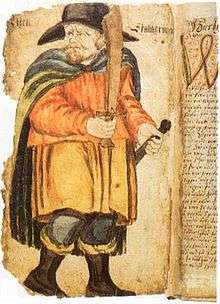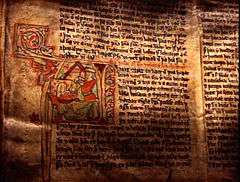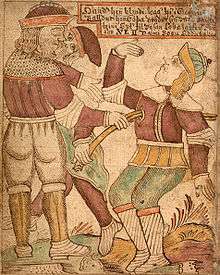Sagas of Icelanders
| Part of a series on |
| Old Norse |
|---|
 |
|
Ancestors |
|
|


The Sagas of Icelanders (Icelandic: Íslendingasögur), also known as family sagas, are prose narratives mostly based on historical events that mostly took place in Iceland in the 9th, 10th, and early 11th centuries, during the so-called Saga Age. They are the best-known specimens of Icelandic literature.
They are focused on history, especially genealogical and family history. They reflect the struggle and conflict that arose within the societies of the early generations of Icelandic settlers.
Eventually many of Icelandic sagas were recorded, mostly in the thirteenth and fourteenth centuries. The 'authors', or rather recorders of these sagas are unknown. One saga, Egils saga, is believed by some scholars[1][2] to have been written by Snorri Sturluson, a descendant of the saga's hero, but this remains uncertain. The standard modern edition of Icelandic sagas is known as Íslenzk fornrit.
List of the Sagas of Icelanders
- Bandamanna saga – Bandamanna saga
- Bárðar saga Snæfellsáss
- Bjarnar saga Hítdœlakappa
- Droplaugarsona saga
- Egils saga Skalla-Grímssonar – Egil's Saga
- Eiríks saga rauða – Saga of Erik the Red
- Eyrbyggja saga
- Færeyinga saga
- Finnboga saga ramma
- Fljótsdæla saga
- Flóamanna saga
- Fóstbrœðra saga (two versions)
- Gísla saga Súrssonar, (two versions) of an outlaw poet – Gísla saga
- Grettis saga
- Grœnlendinga saga – Greenland saga
- Gull-Þóris saga
- Gunnars saga Keldugnúpsfífls
- Gunnlaugs saga ormstungu
- Hallfreðar saga (two versions)
- Harðar saga ok Hólmverja
- Hávarðar saga Ísfirðings – The saga of Hávarður of Ísafjörður
- Heiðarvíga saga
- Hrafnkels saga
- Hrana saga hrings (post-medieval)
- Hænsna-Þóris saga
- Kjalnesinga saga
- Kormáks saga
- Króka-Refs saga
- Laurentius Saga
- Laxdæla saga
- Ljósvetninga saga (three versions)
- Njáls saga
- Reykdœla saga ok Víga-Skútu
- Svarfdœla saga
- Valla-Ljóts saga
- Vatnsdœla saga
- Víga-Glúms saga
- Víglundar saga
- Vápnfirðinga saga
- Þorsteins saga hvíta
- Þorsteins saga Síðu-Hallssonar
- Þórðar saga hreðu
- Ölkofra saga
Gaukur's Saga – A Lost Saga
The Saga of Gaukur á Stöng is believed to have existed but is now considered lost. The saga – set in the anthology of sagas known as Möðruvallabók between Njáls saga and Egils saga Skalla-Grímssonar – tells of a man named Gaukur Trandilsson who lived in the 10th century. Gaukur is mentioned in chapter 26 of Njáls saga. Icelandic professor and poet Jón Helgason managed to decipher a line that read "Let Trandilsson's story be written here. I am told that [Mr.] Grim knows it." However, the story was never put to paper. The Grim mentioned in the manuscript is believed to have been Grímur Þorsteinsson, knight and governor (c. 1350).
Gaukur is reported to have been an exceptionally brave and gentle man. He was the foster brother of Ásgrimur. However, it is said that he had a falling out with his foster brother, who ultimately killed him.
Gaukur must have been a well known figure in Icelandic folklore as he is mentioned in not only Njáls Saga but also the Íslendigadrápa, a poem about the Icelandic heroes. He is also mentioned on a tomb in the Orkney Islands, where a runic inscription translates to "These runes were carved by the man who was the most knowledgable of runes in the west of the sea, using the axe that belonged to Gaukur Trandilsson in the south of the land".[3] The south of the land refers to Iceland.[3]
Explanations for saga writing
Icelanders produced a high volume of literature relative to the size of the population. Historians have proposed various theories for the high volume of saga writing:
- The unique nature of the political system of the Icelandic Commonwealth created incentives for aristocrats to produce literature.[4][5] Because new principalities lacked internal cohesion, a leader typically produced Sagas "to create or enhance amongst his subjects or followers a feeling of solidarity and common identity by emphasizing their common history and legends".[4] Leaders from old and established principalities did not produce any Sagas, as they were already cohesive political units.[4]
- The production of literature was a way for chieftains to create and maintain social differentiation between them and the rest of the population.[5]
- Later (late 13th century and 14th century) saga-writing was motivated by the desire of the Icelandic aristocracy to maintain or reconnect links with the Nordic countries by tracing the ancestry of Icelandic aristocrats to well-known kings and heroes to which the contemporary Nordic kings could also trace their origins.[5]
See also
References: English translations
- Örnólfur Thorsson (1997). The Complete Sagas of Icelanders. 5 vols. Reykjavik: Leifur Eiriksson Publishing Ltd.[6]
- Örnólfur Thorsson, et al. (eds.) (2000) The Sagas of the Icelanders: a selection. Penguin Books
- ↑ Egil's Saga, English translation, Penguin Books, 1976, introduction by Hermann Pálsson and Paul Edwards, p.7
- ↑ Sigurður Nordal had this to say in his edition of Egils saga: "This matter will never be settled fully with the information we now have. … As for me, I have become more and more convinced, as I gained a better understanding of Egils saga that it is the work of Snorri, and I will henceforth not hesitate to count the saga among his works, unless new arguments are presented, which I have overlooked."
- 1 2 Naumann, Hanspeter (2011); "Die Saga von Njal und dem Mordbrand", p. 326, ISBN 978-3-8258-8416-1, 2011
- 1 2 3 Kristinsson, Axel (2003-06-01). "Lords and Literature: The Icelandic Sagas as Political and Social Instruments". Scandinavian Journal of History. 28 (1): 1–17. doi:10.1080/03468750310001192. ISSN 0346-8755.
- 1 2 3 Eriksen, Anne; Sigurðsson, Jón Viðar (2010-01-01). Negotiating Pasts in the Nordic Countries: Interdisciplinary Studies in History and Memory. Nordic Academic Press. ISBN 9789185509331.
- ↑ "The Complete Sagas of Icelanders". Sagas.is. Retrieved 2010-04-14.
References: studies
- Arnold, Martin (2003). The Post-Classical Icelandic Family Saga. Lampeter: Edwin Mellen Press
- Karlsson, Gunnar (2000). The History of Iceland. Minneapolis: University of Minnesota Press
- Liestol, Knut (1930). The Origin of the Icelandic Family Sagas. Cambridge MA: Harvard University Press
- Miller, William Ian (1990). Bloodtaking and Peacemaking: Feud, Law, and Society in Saga Iceland. Chicago: University of Chicago Press
External links
- Icelandic Saga Database – a website with all the Icelandic sagas, along with translations into English and various other languages
- Proverbs and Proverbial Materials in the Old Icelandic Sagas
- Icelandic sagas – a selection in Old Norse
- Sagnanet – photographs of some of the original manuscripts
- Harmony of the Vinland voyages
- Icelandic Saga Map – an online digital map with the geo-referenced texts of all of the Íslendingasögur

